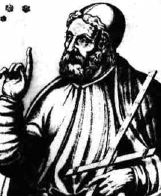

We know very little of Ptolemy's life. His name, Claudius Ptolemy, is of course a mixture of the Greek Egyptian "Ptolemy" and the Roman "Claudius". This would indicate that he was descended
from a Greek family living in Egypt and that he was a citizen of Rome.
Ptolemy definitely made astronomical observations from Alexandria in Egypt during the years from 127 to 141. We suspect his teacher was Theon of Smyrna, who was both an observer and a mathematician who had written on astronomical topics such as
conjunctions, eclipses, occultations and transits.
The earliest, and perhaps most important of Ptolemy's work that has survived is the Almagest, a treatise in 13 books. It gives in detail the mathematical theory of the motions of the Sun, Moon, and planets. Ptolemy made his
most original contribution by presenting details for the motions of each of the planets. His theories were not superseded until a century after Copernicus
presented his heliocentric theory in 1543.
Ptolemy first of all justifies his description of the universe based on the earth-centered system described by Aristotle. It is a view of the world based on a fixed
earth around which the sphere of the fixed stars rotates every day, this carrying with it the spheres of the sun, moon, and planets. Ptolemy used geometric
models to predict the positions of the sun, moon, and planets, using combinations of circular motion known as epicycles. Having set up this model, Ptolemy
then goes on to describe the mathematics which he needs in the rest of the work. In particular he introduces trigonometrical methods based on the chord function.
Ptolemy devised new geometrical proofs and theorems. He obtained, using chords of a circle and an inscribed 360-gon, the approximation π = 3 + 17/120 = 3.14166.
He used formulas for the chord function which are analogous to our formulas for sin(a+b), sin(a–b) and sin(a/2) to create a table of the chord function at intervals of 1/2 a degree.
This occupies the first 2 of the 13 books.
Based on his observations of solstices and equinoxes, Ptolemy then found the lengths of the seasons and, based on these, he proposed a simple model for the sun
which was a circular motion of uniform angular velocity, but the earth was not at the centre of the circle but at a distance called the eccentricity from this
centre. This theory of the sun forms the subject of Book 3.
In Books 4 through 6, Ptolemy gives his theory of the moon. In Book 4 Ptolemy gives Hipparchus's epicycle model for the motion of the moon, but he notes that there are small discrepancies between the model and the observed parameters. In Book 5 he gives a model which improves markedly on the one proposed by Hipparchus. In book 6 he puts forth a theory of eclipses.
The next 2 books deal with the fixed stars, justifying his belief
that the fixed stars always maintain the same positions relative to each other. He also discusses precession, and gives a star catalogue containing over 1000 stars.
The final 5 books of the Almagest discuss planetary theory. This is Ptolemy's greatest achievement in terms of an original contribution. Ptolemy
combined the epicycle and eccentric methods to give his model for the motions of the planets.
This theory is a masterpiece. He created a sophisticated mathematical model to fit observational data, which before Ptolemy's time was scarce, and the model he produced, although complicated, represents the motions of the planets fairly well.
Ptolemy published a major work Geography, written in 8 books, which attempts to map the known world giving coordinates of the major places in terms of latitude and
longitude. It is not surprising that the maps given by Ptolemy were quite inaccurate. Another work on optics is in 5 books. In it Ptolemy studies color, reflection, refraction, and mirrors of various shapes. Ptolemy also wrote a popular account of his results for those knowing less mathematics, a book on astrology, a book on the construction of sundials, and a book about the stereographic projection of the celestial sphere onto a plane.
Because of systematic errors in his works, Ptolemy is accused by some of just correcting Hipparchus' data for precession. Indeed there is some evidence that Ptolemy is guilty of stealing and fabricating data. But he is still one of the most influential Greek astronomers and geographers of his time.